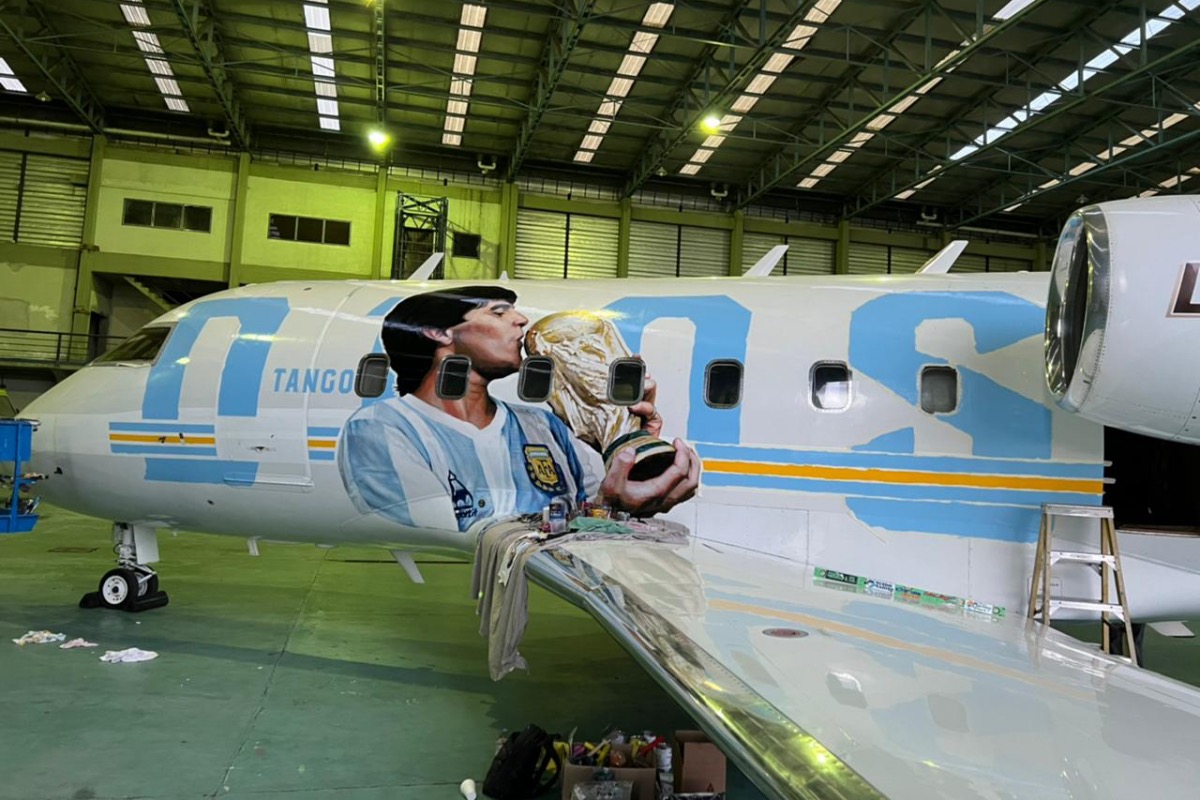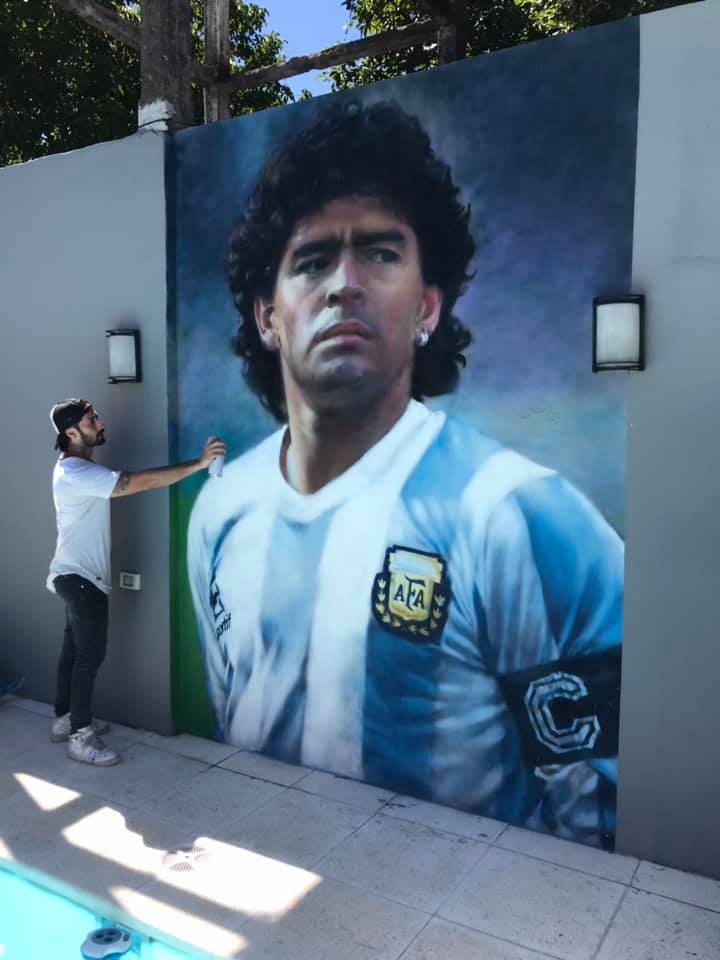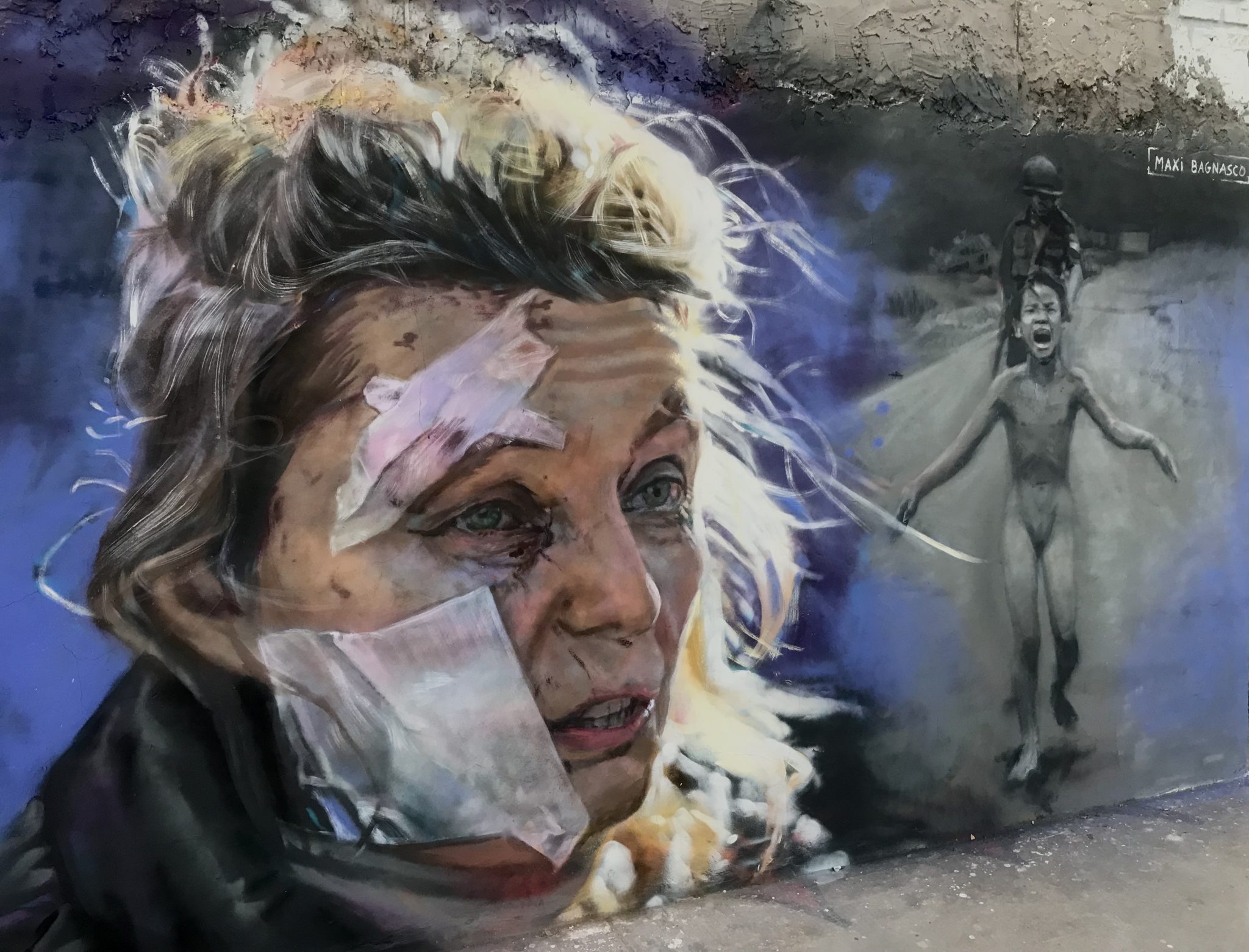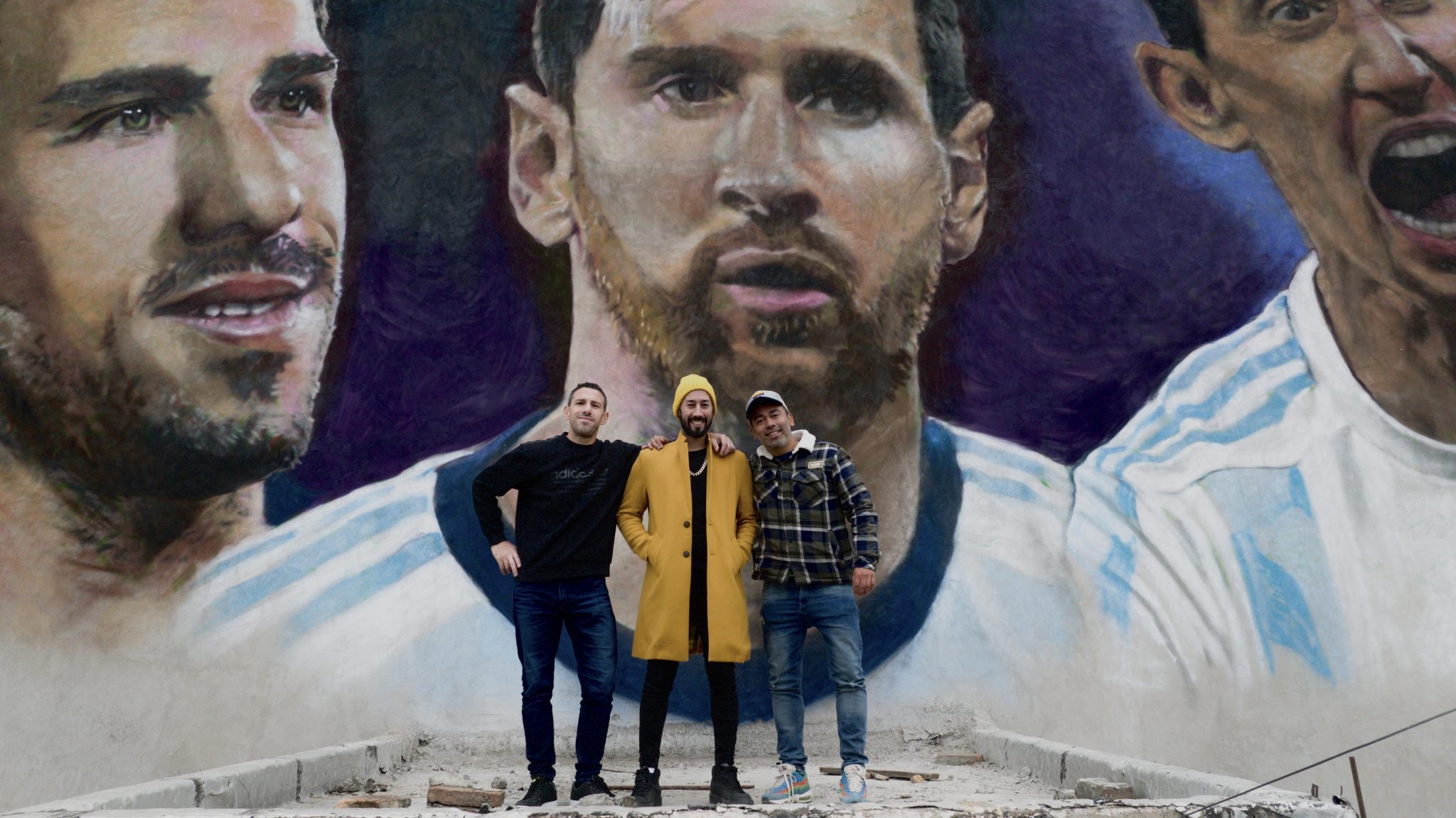

“Tango D10S,” an artistic tribute to Argentine soccer legend Diego Maradona by Maxi Bagnasco (Courtesy of the artist)
“I’ve drawn and painted all my life,” said 40-year-old artist Maxi Bagnasco. “Art was always my way of communicating.”
As an “introverted” child, Bagnasco first gained recognition at the age of nine when his work was published in his local newspaper. Then Argentina’s national newspaper, La Nación, shared his illustrations—in the same year he won a Van Gogh art competition.
As he grew, Bagnasco polished his detailed style of realism.
He began his professional journey at 16 years old with a commission from an Argentine radio station. Shortly after, Maxi received a second commission from U.S heavy-metal band, Megadeth, who asked him to design a t-shirt for the end of their world tour in South Korea.
“Truthfully I never thought this was going to be my profession. I never dreamt about it. When I was younger, 20 years old, I worked with my family and it was going badly,” Bagnasco explained.
He worked with his father in the building trade, as Argentina grappled with a deep economic crisis in the nineties and early 2000s, when the country defaulted on its $100 billion in debt, thrusting over half of the population below the poverty line.
“We were in a very bad situation economically, and with a few pesos, I bought a stand and I went by bus to a plaza to draw caricatures,” Bagnasco said. “It was cold that day and I recall it wasn’t a good experience and I left.”
But soon Maxi’s fortunes began to change when an acquaintance called on his artistic talents at private events in clubs and bars.
“I began doing caricatures, and I would draw 50 people per night and I would have perhaps five events at the weekend,” Bagnasco recalled. “I don’t know how many caricatures I drew, but a lot.”
His artwork eventually gained popularity, as he shared his works featuring one of Argentina’s most revered idols: soccer legend Diego Maradona, who played for the national team 91 times between 1977 and 1994, scoring 34 goals.


Artist Maxi Bagnasco spraypainting a mural of Argentine soccer legend Diego Maradona (Courtesy of the artist)
“I started to draw Diego from childhood,” said Bagnasco. “At my home we weren’t big football fans but we were when it came to the national team. All the family would get together. My most beautiful moments were watching those games of the national team and with Diego as the main player.”
Bagnasco says for many born into adversity, Diego’s journey is inspiring.
“He gave us faith and hope that a kid from the potrero (vacant lots used for soccer), from a slum, could help his family and reach the top,” Bagnasco explained. “(He) represented us across the world.”
Maradona lifted the World Cup trophy only one, in Mexico in 1986, and had success in Italy, choosing to play with Napoli in the south over the affluent northern clubs, forming a bond with supporters while winning the scudetto twice along with the Coppa Italia and a UEFA Cup.
At Diego’s height, many important figures visiting Argentina, like the Rolling Stones, would ask to meet him.
In 2000, Maradona was named one of the joint winners of the FIFA Player of the Century award alongside Brazilian legend Pelé. Two years later, his second goal in the 1986 World Cup quarterfinal match against England —which came on the heels of his notorious “Hand of God” goal in the 51st minute— was voted the “Goal of the Century” by voters on FIFA’s website.
“Diego lived a thousand lives. There is a large number of images and looks and things to paint. I’m never going to get bored,” said Bagnasco, referring to images of Diego in Cuba with blond hair or dressed in fur holding a glass of champagne.
The day after Diego’s passing in November 2020, Bagnasco decided to honor him by painting a work titled “El Día Que Te Fuiste” (The Day That You Departed), sharing the creative process in a video on social media that went viral.
The video led to an Argentine TV channel commissioning him to produce another artwork for them, which was also shared widely on social media.
Then Cristian Malaspina, club president of Argentinos Juniors —for whom a 15-year-old Maradona made his professional debut in October 1976, making a now-iconic nutmeg through an opponent’s legs— asked Bagnasco to paint Diego’s official shrine. The mural took just over a day to complete, with Bagnasco adding the final touches on live TV. International media reported the story before it was officially presented to some of Maradona’s family and former teammates like Checho Batista.
“Afterwards people began to request shrines at their homes,” Bagnasco said. “I did one mural at a house which had a swimming pool and that mural went viral across the world. That week I couldn’t respond to messages—there were so many.”
Bagnasco would go on to paint a series of around 20 Diego murals in downtown Buenos Aires, which garnered more international media coverage, resulting in calls for his work from Greece, Italy, and Qatar, contributing to arguably his most ambitious project to date.
“Just a few months after Diego passed away, Carlos Benavídez, an excellent sculptor, contacted me,” Bagnasco explained. “He has done sculptures of Diego and he told me that he had a project. He wanted to do a painting and sculpture and to take them to Qatar.”
“When they told me to paint the airplane, I immediately said, ‘Find out which paint we have to use,'” Bagnasco recalled.
Each day, at an airbase just outside Buenos Aires, Bagnasco would begin by preparing polyurethane paint, a process that takes about 30 minutes, while trying to keep the project under wraps.
Bagnasco has painted murals since 2016. He always begins his projects by focusing on the technical aspects of the work and trying to detach from the emotional aspects.
Yet, despite being used to creating large murals, Bagnasco needed “to adapt the image to the curvature of the plane.” The project took a week to complete and was paid for by the fintech company, Give and Get. Its founder, Gaston Kolker, describes himself as Maradona’s “biggest fan.”
The name of the plane, “Tango D10S,” is a play on Dios, the Spanish for “God”; Diego’s jersey number, 10; and Argentina’s famous dance, the tango.
The private jet acts as a museum honoring Maradona. It has an image of Maradona lifting the World Cup trophy on the fuselage with his face on the tail alongside the words “1960 to infinity.” The left wing depicts his “Hand of God” goal while the right wing depicts his “Goal of the Century.”
The plane has room for 12 passengers and uses the power of artificial intelligence to bring Diego’s body and voice to life. Fans entering the plane can see a range of soccer memorabilia.
The official unveiling on May 25 caused an international stir, as musicians, global media, Maradona’s family, friends, and teammates such as Ariel Ortega, Ricardo Bochini, and Juan Pablo Sorín, presided. Bagnasco himself was in attendance, having returned from a trip to Kosovo.
“I never imagined that some of my artwork would have this kind of presentation,” said Bagnasco. He’s pleased to see everyone coming together to honor Diego under the banner of the “Tango D10S” project.
The plane is currently flying around Argentina, prior to heading to Spain and Italy. It’s due to arrive in Qatar for the 2022 World Cup in November, before becoming available for private use and then being sold at auction.
Nevertheless, Bagnasco has also gained notoriety away from soccer, notably for his mural in Buenos Aires entitled “No to War,” an anti-war depiction of injured women in the Ukraine-Russia war and includes the historic 1972 image of a child fleeing from napalm in Vietnam.


“No a la guerra,” or “No to War,” by Maxi Bagnasco (Courtesy of the artist)
Outside Argentina, Bagnasco has left his artistic footprint in Miami, Kosovo, and Russia.
Most recently, he unveiled another mural standing seven meters high by 14 meters wide on the side of a building. “De Nuestros Barrios al Mundo” (From Our Neighborhoods To The World) is a creation born after a meeting between Bagnasco and a trader.
The image depicts three Argentine footballers who all hail from the city of Rosario: Lionel Messi, Ángel Di María, and Maxi Rodríguez. The the organizers selected “a common neighborhood” away from the city center, to honor the players’ humble beginnings.


“De Nuestros Barrios al Mundo,” or “From Our Neighborhoods to the World,” a mural by Maxi Bagnasco, center, depicts three Argentine soccer legends who all hail from the town of Rosario (Courtesy of the artist)
What distinguishes this artwork, according to Bagnasco, is that it is “the only mural which united players from both sides,” referring to the fierce crosstown rivalry between the clubs Rosario Central and Newells Old Boys.
Rodríguez, recently retired, visited the mural with Bagnasco on a couple of occasions, climbing the “broken ladder” to admire the image from the top of the scaffolding. As a gesture of his gratitude, Rodríguez gave Bagnasco an Argentine jersey he wore prior to the 2010 World Cup and another signed one.
“Di María published an (Instagram) story, thanking me,” recalled Bagnasco.
He hopes news of the mural and the other players’ gestures will eventually reach Messi, captain of the national team since 2011 and its all-time leading scorer, with 86.
Following Copa América success in 2021 and this year’s Finalissima win against Italy at Wembley in June, Bagnasco, who also teaches art to students, intends to design new murals ahead of the World Cup in Qatar. He is also optimistic about the Albiceleste’s chances of winning.
“We are all behind the ‘Scaloneta,” says Bagnasco, using the affectionate name for manager Lionel Scaloni’s team. “Now the team has demonstrated that it is good at winning or overcoming all the previous obstacles.”
***
Bala Chambers is a freelance multimedia journalist. Twitter: @BalaChambers


